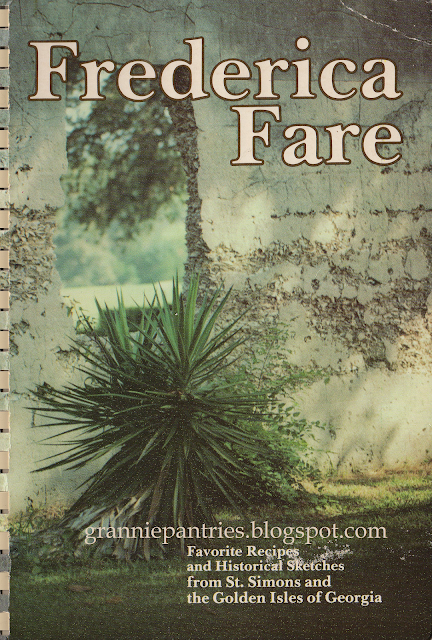Frederica Fare (Parents Association of Frederica Academy, St. Simons Island, Georgia, 1977) boasts right on the cover that this is a collection of both recipes and "historical sketches."
If you're not sure what historical sketches might mean, they're not sketches from townsfolk who lived 100 years ago or anything like that. The crumbling building in the cover photo is a hint: they're sketches of historical buildings. And I have to admit that I got so distracted by the agenda of those historical sketches that I decided to focus on them first. I'll post some recipes from this book later, but today, we're looking at the buildings sketched by L. Josey and the accompanying captions to describe them.
The first sketch in the book-- before the beverages chapter-- shows a lighthouse with the keeper's cottage. It looks nice and remote, the kind of place where a misanthrope might be able to hole up and not be bugged by the neighbors. (Not that I would know anything about misanthropy....)
It seemed pretty nice. And then I read the accompanying caption and realized what kind of book this is.
It notes that this lighthouse was built in 1872 to replace the original 1810 version that was "torn down by the residents of St. Simons when they abandoned the island during the War between the States." Yep-- this seemingly innocuous community cookbook is also an effort to reframe the Civil War to put the South in a better light.
There's also a sketch of a church.

Bet you can't guess its backstory!
Or maybe you can. "The present church was built in 1884 ... to replace the church which had been destroyed by Federal forces during their occupation of St. Simons in the War Between the States."
Aside from pointing out how St. Simons had to replace buildings destroyed during the Civil War, the book also puts a lot of emphasis on what it refers to as a "slave hospital," as if to suggest that the enslaved people couldn't possibly have had it all that bad since there was an actual hospital dedicated to their care. The ruins on the cover are actually of this building, but there is a full sketch inside.
And the description tries to make it sound quite impressive.
"There were two nurses on duty at all times and a doctor was brought in when needed. According to plantation records, approximately one thousand dollars a year was spent on medicine...." I am sure the people who were held captive, forced to work without pay, and otherwise treated as if they were not, in fact, human beings were extremely impressed. (And I would not be at all surprised if they were in fact subjected to some horrific experiments without their consent.)
And did you catch the line about the ruins being part of "the Sea Island Golf Club"? In case you wondered how that turned out, there is a sketch.
And a description.
In short, the Sea Island Golf Club is a place where rich people can play golf and also view ruins of a place of human suffering and imagine this was a sign of how much the enslavers cared. (Yep--
still around! The promotional materials say it was "completely redesigned... in 2019," so maybe there is some slight recognition of the unseemliness, but not enough to, you know, do something more respectful than turning the site into a golf course.)
Ugh. Okay, just so this post does not completely ruin everyone's day, I also found one sketch that occasioned some hopeful speculation: The Mahoney-McGarvey House.
It looks pretty. It wasn't built until 1891, so there's no Civil War history to discuss. And the caption makes me wonder if there's a hidden love story.
How many people leave a mansion that was in their family for more than half a century to a "close friend"? I suspect that this might be code for a lesbian couple that figured out how to care for each other in an era when such relationships were afforded no legal recognition.
Granted, I could be wrong. A preliminary Google search just found information about the architecture, not about the relationship between Mahoney and McGarvey. I imagine I could find out more if I went on a deeper dive, but after contemplating all the dark history treated so dismissively, I just want something at least a little nice to end on. So Mahoney and McGarvey were in love. Mahoney figured out how to make sure McGarvey was still cared for, even after her death. And if that's not the story, I don't want to know! Just give me a sweet story for Pride Month! Okay, I promise that next time I mention this book, I'll look at actual recipes. The historical sketches were just too egregious to gloss over....











Ah yes, I used to know a woman who grew up in South Carolina in the 1950s who learned about the war of northern aggression in school. She didn't buy into that idea later in life. I'm not aware of the history of the golf course I live next to. This end is by older, less expensive condos and a trailer park, but I don't know where the entrance is, so maybe that's in a more posh neighborhood.
ReplyDeleteIt's good to know that people can go beyond what they learned as kids....
DeleteIf you ever go to some history museums in Georgia, you can see that they are still sore about General Sherman.
ReplyDeleteThat does not surprise me one bit!
Delete